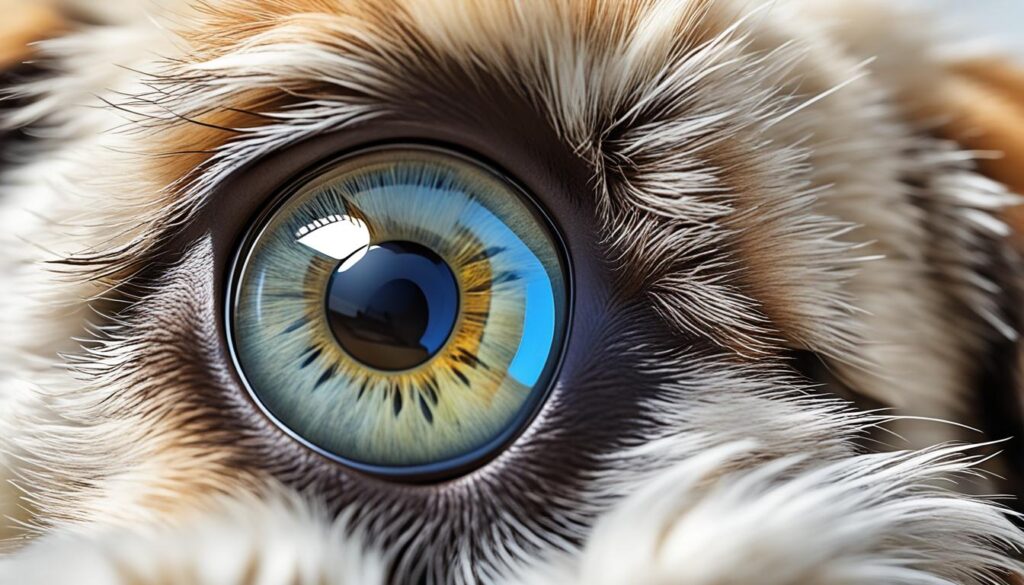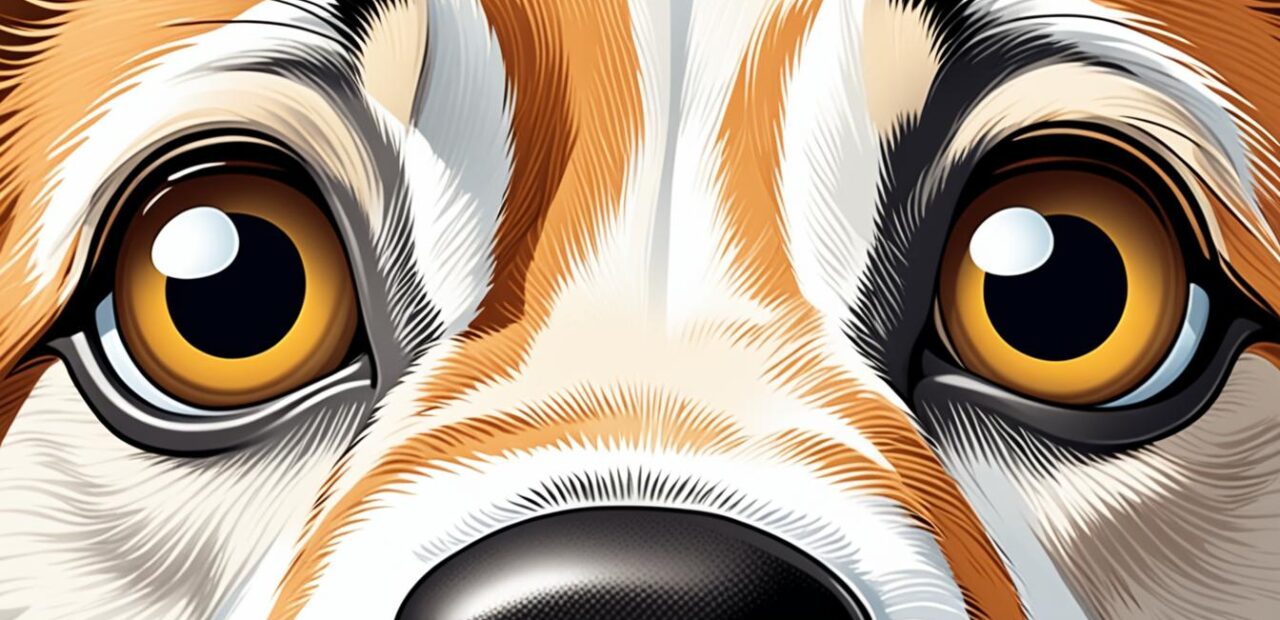Puppy Eyes: Eye Health and Common Issues
Did you know that dogs are more prone to eye problems than humans? It’s true. From corneal ulcers to cataracts, our furry friends can experience a wide range of canine eye conditions. As a responsible pet owner, it’s crucial to be aware of these common issues and take proactive steps to maintain your puppy’s eye health.
Key Takeaways:
- Canine eye problems are common and can impact your puppy’s overall well-being.
- Recognizing the signs of eye problems and seeking prompt veterinary care is essential.
- Regular check-ups and eye exams are crucial for monitoring and treating any eye issues.
- Practicing preventive care, such as keeping your dog’s eyes clean, can help prevent certain conditions.
- By prioritizing eye health, you can ensure your puppy’s eyes remain healthy and vibrant for years to come.
Common Eye Conditions in Dogs
Dogs can experience a variety of eye conditions, which can range from minor irritations to serious vision-threatening problems. It’s essential for pet owners to be aware of these common canine eye conditions and understand the signs to watch out for. By recognizing the symptoms early on, you can seek prompt veterinary care and ensure your dog’s eye health is properly managed.
Corneal Ulcers
Corneal ulcers are scratches or abrasions on the cornea, which is the clear outer layer of the eye. They can be caused by trauma, foreign objects, or underlying conditions that lead to corneal damage. If left untreated, corneal ulcers can result in pain, redness, and even blindness.
Dry Eye Disease
Dry eye disease, also known as keratoconjunctivitis sicca, is a condition characterized by inadequate tear production. This can lead to discomfort, irritation, and inflammation of the eyes. Without proper lubrication, the cornea can become dry and prone to infections.
Eyelid and Eyelash Abnormalities
Abnormalities of the eyelids and eyelashes, such as entropion, distichia, ectopic cilia, and eyelid tumors, can cause irritation and discomfort for dogs. Entropion is when the eyelid folds inward, causing the lashes to rub against the cornea. Distichia is when extra eyelashes grow abnormally, while ectopic cilia are eyelash-like hairs that grow inside the eyelid, touching the cornea.
Corneal Inflammation
Corneal inflammation, also known as keratitis, can result from chronic irritation, allergies, infections, or immune system defects. It can cause redness, pain, and discomfort in the eyes. Without proper treatment, corneal inflammation can lead to corneal degeneration and vision problems.
Uveitis
Uveitis refers to inflammation inside the eye, specifically in the uvea, which is the middle layer of the eye. It can be caused by infections, trauma, autoimmune diseases, or other underlying conditions. Uveitis can lead to redness, discharge, squinting, and potential damage to the delicate structures within the eye.
Glaucoma
Glaucoma is a serious, vision-threatening condition that occurs when there is increased pressure within the eye. It can be primary (hereditary) or secondary (caused by underlying conditions). Glaucoma can lead to severe pain, redness, cloudiness, and potentially irreversible damage to the optic nerve, resulting in blindness.
Cataracts
Cataracts refer to the clouding of the lens inside the eye, causing blurry vision and potentially leading to blindness. Cataracts can develop due to aging, genetics, trauma, or underlying health conditions. Early detection and treatment are crucial to manage cataracts effectively.
Retinal Disease
Retinal disease encompasses various conditions that affect the retina, which is the thin layer of tissue at the back of the eye responsible for capturing visual images. Progressive retinal atrophy and sudden acquired retinal degeneration syndrome are examples of retinal diseases that can lead to vision loss or blindness.
To ensure your dog’s eye health, it is important to monitor their eyes regularly and seek veterinary care at the first sign of any abnormalities or symptoms. Early intervention and proper treatment can help manage these common eye conditions and preserve your dog’s vision and overall well-being.
Eye Care for Puppies
When puppies are born, their eyelids are closed, and they typically open after about 10 to 14 days. It is important to monitor the development of their eyes and watch for any signs of infection or trauma. Puppy vision improves with age, and by about 8 weeks, their vision will be almost at adult level.
Common eye problems in puppies include trauma, which can cause corneal scratches or irritation from foreign objects, and congenital defects, which may be genetic or a result of issues in the uterus.
Regular veterinary visits and eye exams are crucial for monitoring and treating any eye problems that may arise in puppies.

Signs of Eye Problems in Puppies
It is essential for puppy owners to be aware of potential signs of eye problems in their furry companions. Some common indicators include:
- Excessive tearing
- Redness or swelling around the eyes
- Discharge or crust formation
- Cloudiness or haziness in the eyes
- Frequent blinking or rubbing of the eyes
If you notice any of these signs, it is important to consult a veterinarian for a thorough examination and appropriate treatment.
Preventing Eye Problems in Puppies
While some eye problems in puppies may be unavoidable, there are steps you can take to minimize the risk:
- Keep your puppy’s environment clean and free from potential eye irritants, such as dust, pollen, and chemicals.
- Avoid sharp objects or foreign bodies that may cause eye injuries.
- Ensure your puppy receives all necessary vaccinations to prevent infectious diseases that can affect the eyes.
- Feed your puppy a balanced diet rich in essential nutrients to support overall eye health.
- Regularly groom your puppy, paying attention to the area around the eyes to prevent matting and irritation.
| Eye Problem | Causes | Treatment |
|---|---|---|
| Trauma | Injury or foreign objects | Topical medication, surgery if necessary |
| Congenital Defects | Genetic or developmental issues | Medical management, surgery if applicable |
“Proper eye care plays a vital role in ensuring the overall health and well-being of your puppy. By monitoring their eye development, recognizing any signs of problems, and seeking prompt veterinary care, you can help safeguard their precious vision.”
– Dr. Samantha Thompson, DVM
Symptoms of Dog Eye Problems and Diagnostic Tests
When it comes to your dog’s eye health, recognizing the symptoms of eye problems and seeking prompt veterinary care is crucial. Keep a close eye on your furry friend and watch for any signs of discomfort or abnormalities in their eyes. Some common symptoms of dog eye problems include:
- Red inner eyelids: Inflammation or irritation of the inner eyelids can cause redness.
- Discharge: Excessive discharge, such as mucus or pus, may indicate an infection or inflammation.
- Cloudiness: Cloudy or opaque eyes can be a sign of various eye conditions, including cataracts.
- Dull eye surface: A lack of brightness or shine in the eyes may suggest an underlying issue.
- Excessive tearing: Epiphora, or excessive tearing, can be caused by conditions such as blocked tear ducts or allergies.
- Tear-stained fur: Tear stains on the fur around the eyes can be a result of epiphora or conjunctivitis.
If you observe any of these symptoms, it is important to consult a veterinarian for a proper diagnosis and treatment. Veterinarians have several diagnostic tests at their disposal for pinpointing the cause of dog eye problems. These tests include:
- Fluorescein: This test uses a special dye to identify corneal ulcers, which are scratches or abrasions on the cornea.
- Schirmer Tear Test: This test measures tear production to identify conditions like dry eye disease or epiphora.
- Ocular pressure measurement: This test helps detect conditions like glaucoma by measuring the pressure inside the eye.
- Ophthalmoscopy: Using an ophthalmoscope, veterinarians can examine the inside of the eye to detect abnormalities such as cataracts or retinal disease.
By combining a careful observation of symptoms with these diagnostic tests, veterinarians can determine the underlying cause of the eye problems and provide appropriate treatment. Remember, early intervention is key to preserving your dog’s eye health and vision.
Conclusion
Proper dog eye health is crucial for your furry friend’s overall well-being. By prioritizing regular veterinary care and preventive measures, you can ensure your dog’s eyes remain healthy and vibrant throughout their life.
Scheduling routine check-ups with your veterinarian and opting for regular eye exams will help identify any eye problems early on, allowing for prompt treatment. This proactive approach can prevent potential complications and ensure the best outcomes for your dog’s vision.
In addition to professional care, practicing preventive care at home is equally important. Keeping your dog’s eyes clean and free from irritants, such as dust or debris, can go a long way in preventing certain eye conditions. Using a vet-approved eye wash solution and gently wiping their eyes with a clean, damp cloth can help maintain good ocular hygiene.
Remember, as a responsible pet owner, staying vigilant and observant is key. If you notice any signs of discomfort, such as excessive tearing, redness, or discharge, seek veterinary care promptly. Timely intervention can prevent minor issues from escalating into more severe conditions and ensure that your dog’s eyes stay healthy for years to come.
FAQ
What are the most common eye conditions in dogs?
The most common eye conditions in dogs include corneal ulcers, dry eye disease, eyelid and eyelash abnormalities, corneal inflammation and degeneration, uveitis, glaucoma, cataracts, and retinal disease.
What eye problems can puppies experience?
Common eye problems in puppies include trauma, which can cause corneal scratches or irritation from foreign objects, and congenital defects, which may be genetic or a result of issues in the uterus.
What are the symptoms of dog eye problems?
Dog eye problems can manifest in symptoms such as red inner eyelids, discharge, cloudiness, dull eye surface, excessive tearing, and tear-stained fur.
How are dog eye problems diagnosed?
Veterinarians may use tests such as fluorescein to identify corneal ulcers, the Schirmer Tear Test to measure tear production, ocular pressure to detect glaucoma, and ophthalmoscopes to examine the inside of the eye for diagnosing dog eye problems.
How can I take care of my dog’s eyes?
Proper eye care includes regular veterinary check-ups and eye exams to identify and treat any eye problems early on. Additionally, practicing preventive care, such as keeping your dog’s eyes clean and free from irritants, can help prevent certain eye conditions.


